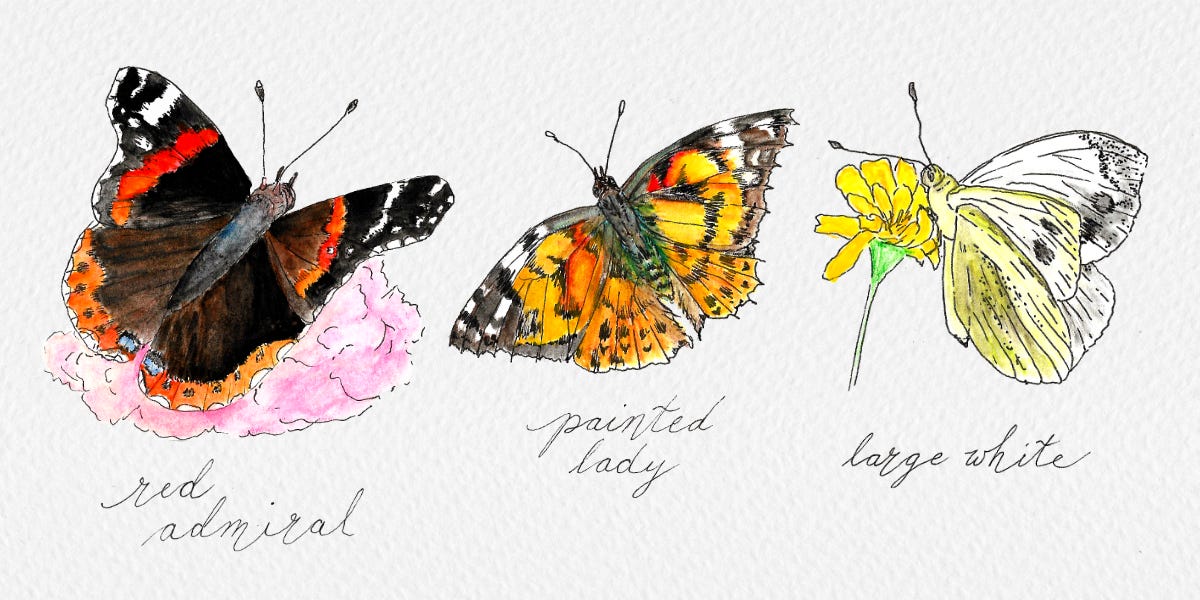Whilst August has had some hot spells, it has also been a month where you can really feel the season turning. Up here in Northumberland, I’ve been much more aware of the sun setting earlier (and there have been some beautiful sunsets) so that it is now dark when I go to bed, rather than still light. The countryside has entered that ‘dusty’ phase, where greens turn to yellows and browns after drier weather, and plants start to set seed. Quite a lot of the fields around us have already had their crops harvested and neat bales are appearing in the margins where you can now more clearly see the brown hares resting in their scrapes, or the pheasants strutting through the stubble.
1st August
The untidy yellow flowers of Common Ragwort have been late to flower this year - I'm only just becoming aware of them in quantity now that we're into August when they will sometimes appear as early as June.
Common ragwort is a great plant for butterflies, moths and their caterpillars, with more than 200 species recorded on it in the UK. They are a particular favourite for the caterpillars of the Cinnabar moth but there are actually 30 varieties of nationally rare or scarce insects that rely completely on ragwort for their food.
Unfortunately, Common Ragwort does not have a good reputation as it is widely known for being toxic to grazing livestock, including horses. It is covered by The Weeds Act 1959 and the Ragwort Control Act 2003, which provide for a landowner to control the spread of ragwort if necessary (given that it is also illegal to uproot any wildflower). However, ragwort only really causes a problem when dried and accidentally mixed into animal feed - most livestock will actually avoid eating the live plant. The least invasive way to control ragwort is actually to ensure that soil isn't bare, as ragwort seeds only germinate on bare earth. There's an excellent article from Friends of the Earth that debunks the myths around Ragwort, if you'd like to know more.
10th August
On a similar theme, I saw more butterflies today than I think I’ve seen in the whole rest of the summer! At least they’re appearing now that we’ve had some longer spells of settled and sunny weather, but the lack of pollinators this year has been incredibly worrying.
Earlier in the year we saw quite a few Orange-tips - and then nothing. But today there were Large Whites, Meadow Browns, Painted Ladies and Red Admirals - all common varieties (or ‘not so common’ this year) but still a joy to see.
I’m always interested to draw and paint wildlife, as it really challenges you to look with more awareness for form and colour. I had always thought of Red Admirals as being black, white and red - whilst in reality, they have a beautiful dark chocolate sheen to their wings (rather than pure black) with bands that blend from red to a lighter orange and a small ‘peacock eye’ spot on each lower wing! And despite the name, Large Whites aren’t really white - but have a host of grey and yellow/green tones to their body and wings (particularly when seen from below).
The lack of pollinators this year has reminded me that we could do more in our garden with planting to provide food sources (as I’d prefer they not eat my vegetable crops!) We have quite a bit of mature hedging which doesn’t really flower and does have a lot of nasty thorns, so we might replace some of that with some of the traditional pollinator favourites like budleia and hebe, but it is also an incentive to get my herb garden started as butterflies love a whole range of herbs from marjoram to lavender.
22nd August
Whilst the Ragwort has been slow to flower and the butterflies shy to emerge in any great number, I have already started to notice some Autumn colours amongst the late summer greens and browns. In particular, the bright red and orange of Rowan berries have been calling to me this year and it was lovely to stop and study these for a time in order to add a study to my sketchbook.
I really enjoyed attempting to depict the shiny berries using watercolour and tried both a red berry on its own as well as a bunch of the more orange berries.
Rowan trees can be found in many habitats and are part of the rose family (Rosaceae). This tree goes by many names, including Mountain Ash (in Scotland), quickbeam, wicken and witchwood. The Celts revered it as a sacred tree with protective properties to ward off witches and evil spirits - hence it was traditionally planted near to homes and livestock as well as burial sites. The berries are full of vitamin C and although they shouldn't be eaten raw, make a lovely tart jam.







What a lovely summary of the month - I also noticed more butterflies this last week than most of Summer. I adore your butterfly sketches ❤️
Your sketches are beautiful!